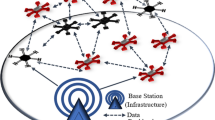Abstract
Drone networks are aerial base stations that can be used to support cellular networks. The underlay spectrum sharing between the three-dimensional (3D) drone small cells (DSCs) downlink network modeled by a 3D Poisson point process and traditional cellular networks modeled by a 2D Poisson point process is introduced. To maximize the DSC network throughput while satisfying the cellular network efficiency constraint, the optimal density of DSC aerial base stations is discussed. The maximum throughput of the DSC user increases almost linearly with the increase of the DSC outage constraint. Effects of directional transmission on DSC networks is further discussed. Besides density control, power and beam control can also be applied in the spectrum sharing between unmanned aerial vehicle (UAV) network and ground network. With the mobility pattern information of UAVs, the delay-tolerant transmissions can be constructed and multiple transmission modes are implemented to carry various types of traffic. Exploiting cognition capability on mobility, UAV network can provide high quality of information services in the highly dynamic environment with limited resources.
Similar content being viewed by others
Notes
- 1.
Reader could refer to (8) and (9) in [10] for the details of air-to-ground channel model.
References
Al-Hourani A, Kandeepan S, Jamalipour A (2014) Modeling air-to-ground path loss for low altitude platforms in urban environments. In: IEEE global communication conference (GLOBECOM), Austin, pp 2898–2904. https://doi.org/10.1109/GLOCOM.2014.7037248
Al-Hourani A, Kandeepan S, Lardner S (2014) Optimal LAP altitude for maximum coverage. IEEE Wirel Commun Lett 3(6):569–572. https://doi.org/10.1109/LWC.2014.2342736
Mozaffari M, Saad W, Bennis M, Debbah M (2015) Drone small cells in the clouds: design, deployment and performance analysis. In: IEEE global communication conference (GLOBECOM), San Diego, pp 1–6. https://doi.org/10.1109/GLOCOM.2015.7417609
Lin X et al (2018) The sky is not the limit: LTE for unmanned aerial vehicles. IEEE Commun Mag 56(4):204–210. https://doi.org/10.1109/MCOM.2018.1700643
Federal Aviation Administration (FAA) (2017) UAS traffic management research transition tea plan. Technical report. https://www.faa.gov/uas/research/utm/media/FAA_NASA_UAS_Traffic_Management_Research_Plan.pdf
Wei Z, Wu H, Huang S, Feng Z (2017) Scaling laws of unmanned aerial vehicle network with mobility pattern information. IEEE Commun Lett 21(6):1389–1392. https://doi.org/10.1109/LCOMM.2017.2671861
Cover T, Thomas J (2012) Elements of information theory. Wiley, New York
Zhang C, Zhang W (2017) Spectrum sharing for drone networks. IEEE J Sel Areas Commun 35(1):136–144. https://doi.org/10.1109/JSAC.2016.2633040
Zhang C, Zhang W (2016) Spectrum sharing in drone small cells. In: Proceedings of IEEE global communication conference (GLOBECOM), Washington. https://doi.org/10.1109/GLOCOM.2016.7842290
Mozaffari M, Saad W, Bennis M, Debbah M (2016) Unmanned aerial vehicle with underlaid device-to-device communications: performance and tradeoffs. IEEE Trans Wirel Commun 15(6):3949–3963. https://doi.org/10.1109/TWC.2016.2531652
Andrews JG, Baccelli F, Ganti RK (2011) A tractable approach to coverage and rate in cellular networks. IEEE Trans Commun 59(11):3122–3134. https://doi.org/10.1109/TCOMM.2011.100411.100541
Bai T, Heath RW Jr (2015) Coverage and rate analysis for millimeter wave cellular networks. IEEE Trans Wirel Commun 14(2):1100–1114. https://doi.org/10.1109/TWC.2014.2364267
Zhang X, Haenggi M (2014) A stochastic geometry analysis of inter-cell interference coordination and intra-cell diversity. IEEE Trans Wirel Commun 13(12):6655–6669. https://doi.org/10.1109/TWC.2014.2339273
Vu M, Devroye N, Tarokh V (2009) On the primary exclusive region of cognitive networks. IEEE Trans Wirel Commun 8:3380–3385. https://doi.org/10.1109/TWC.2009.080454
Bagayoko A, Tortelier P, Fijalkow I (2010) Impact of shadowing on the primary exclusive region in cognitive networks. In: European wireless conference (EW), Lucca, pp 105–110. https://doi.org/10.1109/EW.2010.5483402
Wang Z, Zhang W (2014) Opportunistic spectrum sharing with limited feedback in Poisson cognitive radio networks. IEEE Trans Wirel Commun 13(12):7098–7109. https://doi.org/10.1109/TWC.2014.2363676
Dahama R, Sowerby KW, Rowe GB (2013) Estimating protection distances in spectrum sharing systems. IEEE Trans Signal Process 61(17):4284–4295. https://doi.org/10.1109/TSP.2013.2269901
Wei Z, Feng Z, Zhang Q, Li W (2015) Three regions for space-time spectrum sensing and access in cognitive radio networks. IEEE Trans Veh Technol 64(6):2448–2462. https://doi.org/10.1109/GLOCOM.2012.6503290
Wei Z, Feng Z, Zhang Q, Li W (2015) Three regions for space-time spectrum sensing and access in cognitive radio networks. IEEE Trans Veh Technol 64(6):2448–2462. https://doi.org/10.1109/TVT.2014.2342612
Guo A, Haenggi M (2015) Asymptotic deployment gain: a simple approach to characterize the SINR distribution in general cellular networks. IEEE Trans Commun 63(3):962–976. https://doi.org/10.1109/TCOMM.2014.2387170
Gupta AK, Zhang X, Andrews JG (2015) SINR and throughput scaling in ultradense urban cellular networks. IEEE Wirel Commun Lett 4(6):605–608. https://doi.org/10.1109/LWC.2015.2472404
Lee S, Zhang R, Huang K (2013) Opportunistic wireless energy harvesting in cognitive radio networks. IEEE Trans Wirel Commun 12(9):4788–4799. https://doi.org/10.1109/TWC.2013.072613.130323
Keeler HP, Ross N, Xia A (2015) When do wireless network signals appear Poisson. Available via DIALOG. https://arxiv.org/abs/1411.3757
Andrews JG, Buzzi S, Choi W, Hanly SV, Lozano A, Soong ACK, Zhang JC (2014) What will 5G be? IEEE J Sel Areas Commun 32(6):1065–1082. https://doi.org/10.1109/JSAC.2014.2328098
Carle J, Myoupo JF, Seme D (2001) A basis for 3-D cellular networks. In: Proceedings of the 15th international conference on information networking, Beppu City, pp 631–636. https://doi.org/10.1109/ICOIN.2001.905525
Alam SM, Haas ZJ (2006) Coverage and connectivity in three-dimensional networks. In: Proceedings of the 12th annual international conference on mobile computing and networking, Los Angeles, pp 346–357. https://doi.org/10.1145/1161089.1161128
Zeng Y, Zhang R, Lim TJ (2016) Wireless communications with unmanned aerial vehicles: opportunities and challenges. IEEE Commun Mag 54(5):36–42. https://doi.org/10.1109/MCOM.2016.7470933
Streit RL (2010) Probability generating functional. In: Poisson point processes: imaging, tracking, and sensing. Springer Science & Business Media, Berlin, p 27
Zhou L, Yang Z, Zhou S, Zhang W (2018) Coverage probability analysis of UAV cellular networks in Urban environments. In: Proceeding IEEE international conference on communication (ICC), Kansas City
Guo Z, Wei Z, Feng Z, Fan N (2017) Coverage probability of multiple UAVs supported ground network. Electron Lett 53(13):885–887. https://doi.org/10.1049/el.2017.0800
Author information
Authors and Affiliations
Corresponding author
Editor information
Editors and Affiliations
Section Editor information
Rights and permissions
Copyright information
© 2019 Springer Nature Singapore Pte Ltd.
About this entry
Cite this entry
Zhang, C., Wei, Z., Feng, Z., Zhang, W. (2019). Spectrum Sharing of Drone Networks. In: Zhang, W. (eds) Handbook of Cognitive Radio . Springer, Singapore. https://doi.org/10.1007/978-981-10-1389-8_35-1
Download citation
DOI: https://doi.org/10.1007/978-981-10-1389-8_35-1
Published:
Publisher Name: Springer, Singapore
Print ISBN: 978-981-10-1389-8
Online ISBN: 978-981-10-1389-8
eBook Packages: Springer Reference EngineeringReference Module Computer Science and Engineering




